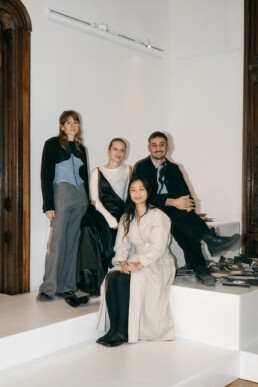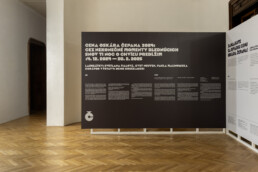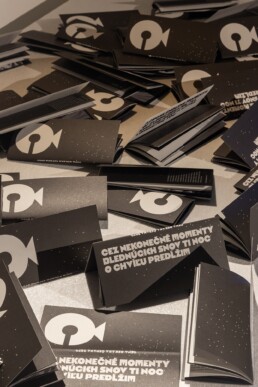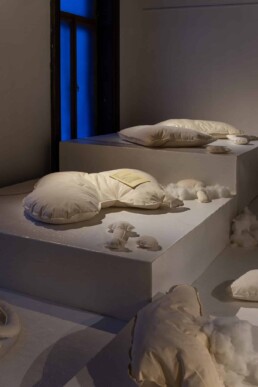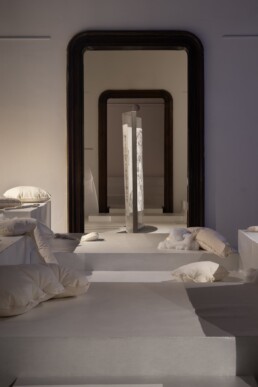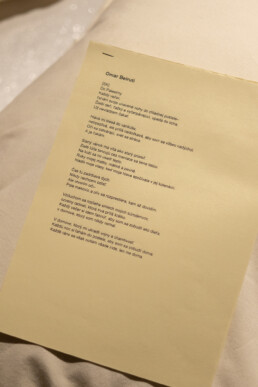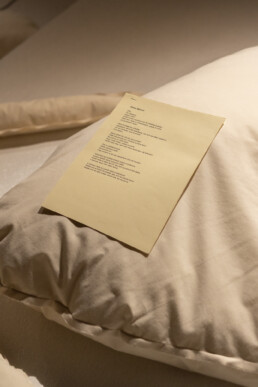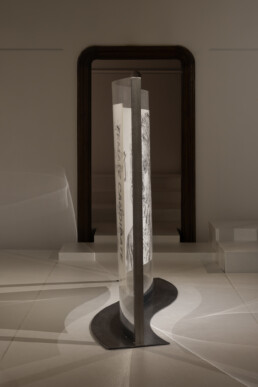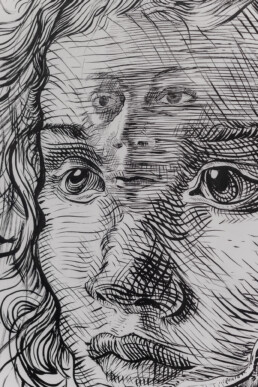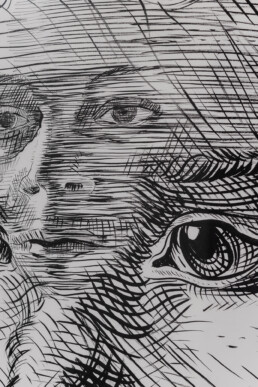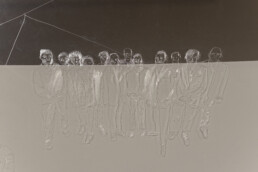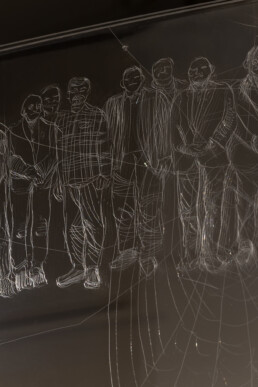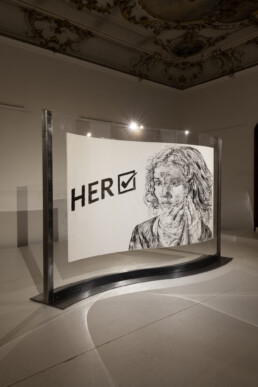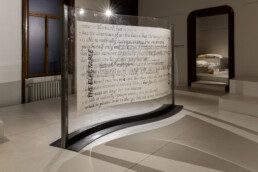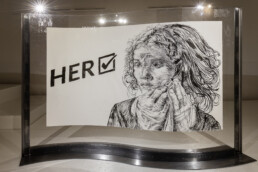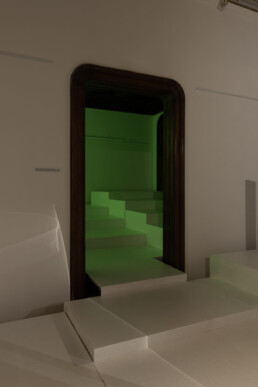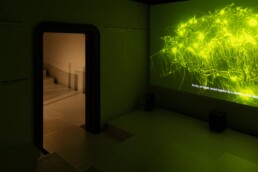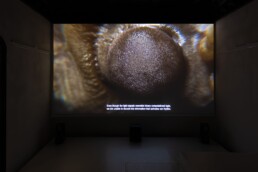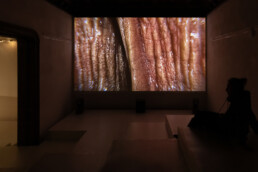Across Endless Moments of Fading Dreams, I’ll Keep the Night a Little Longer For You
Curatorial Text:
/for Slovak scroll down/
Since our new home is in a part of the city that rises uphill from the main train station—on the edge, between the city and a protected nature reserve—winter mornings here are usually different from those below. Most often, they’re veiled in mist, occasionally shrouded in clouds, and once a year, while the city shakes off its morning haze, it remains dark here even at noon.
Stress dragged me out of bed earlier than usual. Sometimes, it feels almost masochistically intoxicating. Hormones make my metabolism kick in faster than normal, the accompanying thirst ensures my body gets enough fluids, and the coffee doesn’t rattle me the way it usually does. From the street, you can see straight into our first-floor apartment. That’s why the blinds stay down, or at „half-mast“—angled to let in as much light as possible, even if it’s only from a streetlamp.
In bed. Your body remains relaxed, warm under a blanket layered over a summer duvet. It’s 5:30 AM, and from the next room, you can hear and smell the moka pot bubbling. Through a crack in the door, you catch a glimpse of a silhouette, side-lit by the streetlamp, cautiously closing the door. The muffled sounds of morning rituals are so calming and familiar that you don’t understand why your mind feels unbearably heavy within its physical shell and slips back into unconsciousness. The waking moment was so brief that your subconscious still clings to fragments of its earlier narrative. This subjective distortion of time gives you enough space to finally lodge a protest:
„I object not only to the current actions but to the burdens of entire generations that shaped me.“
The body is only seemingly fragile and passive…
„Mom, wake up!“
_
Each year, the jury of the Oskár Čepan Award faces the challenging task of selecting the artists who will reflect innovative, rare, and timeless artistic approaches, as well as engaging with pressing global or local discourses and socially contentious topics. The award creates a unique gallery forum where we become active participants in the stories we interpret and connect to broader social contexts.
This year, a strong trio of women artists presents a wide-ranging exploration of media and themes in contemporary art. Their works span reflections on the position of women in patriarchally structured academic environments, powerful testimonies of the lives of the Vietnamese minority in Slovakia, and documentary fiction exploring the limits of human perception and the mystery of why fireflies blink in synchrony.
Their political bodies are not static symbols but active tools for inquiry and change. They transcend theoretical concepts; through art, they become vehicles for negotiation, advocacy, transformation, and research. They dismantle entrenched stereotypes and ideas, forge new forms of communication, and explore our relationship with both the human and non-human world.
The artistic projects of the Oskár Čepan Award laureates for 2024 demonstrate that the body is a site where personal stories intersect with global societal issues, and a platform where new political imagination takes root.
For some time now, I’ve had in mind an excerpt from Ursula K. Le Guin’s Always Coming Home, where she writes: „The people in that time to come will not think of things as past and future. They will look at them as parts of an endless stream that flows in and through and around them. In their lives, the truth will not be something said and done, remembered and handed down, but something being done, being said. Truth will have its being in the living.“
————————————————————————
Kurátorský text:
Keďže nové bývanie máme v tej časti mesta, ktorá sa od hlavnej stanice dvíha hore do kopcov – na okraji medzi mestom a prírodnou rezerváciou – zimné rána tu zväčša bývajú iné ako dole. Najčastejšie sú v opare, zriedka v oblaku, a raz za rok sa stane, že kým v meste sa ranné mlieko rozptýli, u nás je aj pred obedom stále tma.
Stres ma z postele vyhnal skôr, ako som zvyknutý. Občas to býva sadomasochisticky opojné. Hormóny prinútia metabolizmus naskočiť rýchlejšie, sprievodný smäd telu vybaví potrebné tekutiny a káva ma už nerozhádže tak, ako zvykne. Do nášho bytu na prvom poschodí vidieť priamo z ulice. Žalúzie preto ostávajú zatiahnuté alebo len na „pol žrde” – v takom uhle, aby sa do izby kompromisom predralo čo najviac svetla. Hoci len z pouličnej lampy.
V posteli. Telo máš stále uvoľnené a zohriate vďaka deke navrstvenej na letnom paplóne. Je pol šiestej ráno a z izby vedľa počuješ bublať vodu a cítiš výraznú vôňu kávy. V štrbine si všimneš siluetu, z profilu osvetlenú pouličnou lampou, ako opatrne zatvára dvere. Tlmené zvuky ranných rituálov sú tak upokojujúce a familiárne, až nerozumieš vlastnej mysli, ktorá vo fyzickej schránke neznesiteľne oťažie a opäť prepadne do nevedomia. Čas bdelosti bol tak krátky, že podvedomie vo svojej dočasnej pamäti stále drží predošlý naratív. Subjektívne skreslenie času ti dáva dostatok priestoru konečne vzniesť námietku:
„Namietam nielen voči súčasným činom, ale aj voči bremenu celých generácií, ktoré ma formovali.“
Telo je len zdanlivo krehké a pasívne…
Mami, vstávaj!
–
Každoročne má porota Ceny Oskára Čepana neľahkú úlohu vybrať umelcov a umelkyne, ktorí a ktoré budú zrkadliť inovatívne, vzácne a nadčasové výtvarné prístupy, ako aj zaujímavé globálne či lokálne diskurzívne a spoločensky sporné témy. Vzniká tak špecifické galerijné fórum, kde sa stávame aktívnymi účastníkmi príbehov, ktoré interpretujeme a prepájame so širšími spoločenskými súvislosťami. Tento rok nám výrazná trojica umelkýň predstavuje široký mediálny aj tematický výsek zo súčasného umenia – od reflexie pozície ženy v patriarchálne nastavenom akademickom prostredí, cez silné svedectvo o živote vietnamskej menšiny žijúcej na Slovensku, až po dokumentárnu fikciu o limitoch ľudskej percepcie a záhade, prečo svetlušky synchrónne blikajú.
Ich politické telá tu nie sú len statickým symbolom, ale aktívnym nástrojom skúmania a zmeny. Nezostávajú na úrovni teoretického pojmu; prostredníctvom umenia sa stávajú prostriedkom vyjednávania, obhajoby, zmeny či výskumu. Rozkladajú zaužívané stereotypy a predstavy, vytvárajú nové spôsoby komunikácie a skúmajú náš vzťah s ľudským aj mimoľudským svetom.
Umelecké projekty laureátok Ceny Oskára Čepana 2024 dokazujú, že telo je miestom, kde sa stretávajú osobné príbehy s globálnymi spoločenskými problémami, a zároveň platformou, kde vzniká nová politická imaginácia.
V mysli mi rezonuje útržok z knihy Always Coming Home od Ursuly K. Le Guin, v ktorom píše: „Tí, ktorí budú prichádzať, nebudú pozerať na veci ako na minulosť. Budú ich vidieť ako súčasť nekonečného prúdu, ktorý pokračuje, prechádza cez nás a nesie so sebou čas, priestor a všetky bytosti. V ich životoch bude pravda zakorenená nie v spomienkach, ale v živote samotnom, v tej nepretržitej tvorbe a ničote, ktorou je existencia.”
ArtistsKvet Nguyen / Svetlana Fialová / Paula Malinowska Curated byDenis KozerawskiDocumentationLeontína BerkováArchitectureJakub KopecProject CoordinatorNela PučekováVisual IdentityMatúš BuranovskýExhibition ProductionPatrícia ChamrazováPRPetra WesserleExhibition InstallationJozef Pilát / Tomáš Prištiak / Lukáš ProcházkaCopy EditingBeáta Révayová
